CNC machining revolutionizes modern manufacturing, but which setup best suits your needs? Whether you're considering a three axis cnc milling machine, four axis cnc milling machine, or five axis cnc milling machine. Each axis configuration offers unique capabilities for various industries and design complexities.
In this post, you’ll learn the core differences between 3-axis, 4-axis, and 5-axis CNC machines. We’ll explore how each axis impacts precision, cost, and production efficiency to help you choose the best fit for your project’s needs.
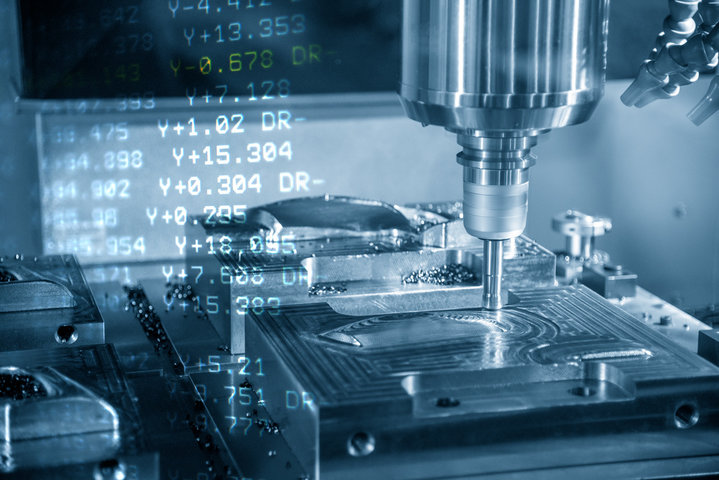
Basics of CNC Machining
CNC (Computer Numerical Control) machining is a manufacturing process that uses computer-controlled machines to cut, shape, and finish various materials. It relies on pre-programmed software to dictate the movement of factory tools and machinery, offering unparalleled precision, efficiency, and repeatability.
How CNC Machining Works
The process begins with a CAD (Computer-Aided Design) model or a 3D design of the desired part. This model is then converted into a CNC program using CAM (Computer-Aided Manufacturing) software. The program contains specific instructions, known as G-code, which guide the machine's tools to create the desired shape.
Advantages of CNC Machining
Compared to traditional machining methods, CNC machining offers several advantages:
Higher precision and accuracy
Increased productivity and efficiency
Reduced human error and labor costs
Ability to produce complex geometries
Consistency and repeatability
Industries Using CNC Machining
CNC machining is used in a wide range of industries, including:
Aerospace: Creating complex parts for aircraft and spacecraft
Automotive: Producing engine components, body parts, and tools
Medical: Manufacturing surgical instruments, implants, and prosthetics
Molds and dies: Creating intricate molds for casting and injection molding
Electronics: Fabricating PCBs, enclosures, and heat sinks
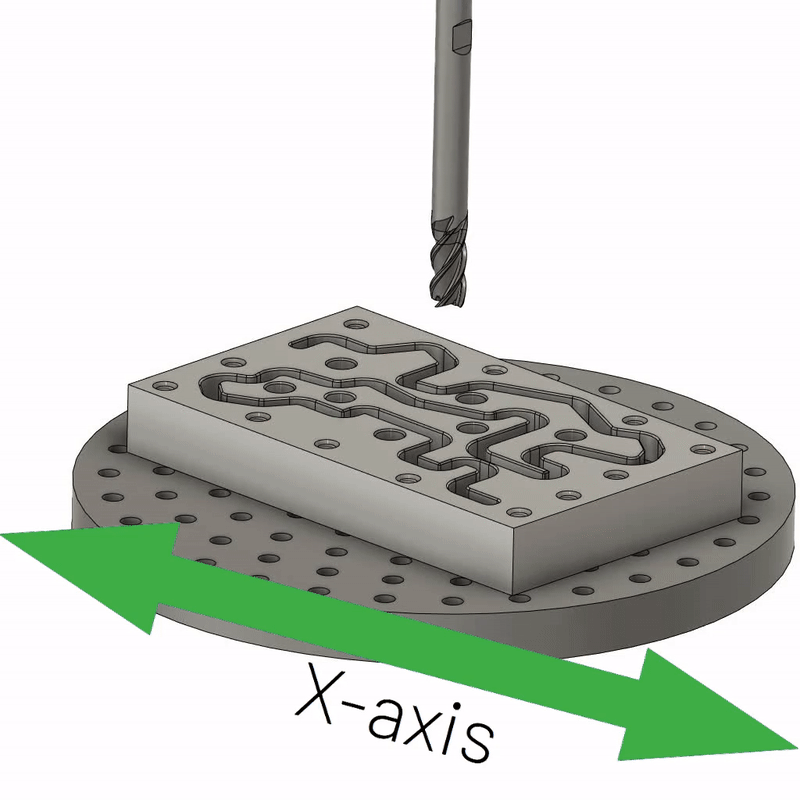
Understanding Axes in CNC Machining
In CNC machining, axes refer to the directions in which the machine tool can move. These movements are essential for creating precise and complex shapes. The number of axes a CNC machine has determines its capabilities and the types of parts it can produce.
Axes in 3-Axis Machining
3-axis CNC machines are the most common and basic type. They have three linear axes:
X-axis: Horizontal movement from left to right
Y-axis: Horizontal movement from front to back
Z-axis: Vertical movement up and down
The tool moves along these axes to cut the workpiece, creating a three-dimensional shape. However, the tool remains perpendicular to the workpiece, limiting the complexity of the parts that can be produced.
Additional Axes in 4-Axis and 5-Axis Machining
To overcome the limitations of 3-axis machining, 4-axis and 5-axis CNC machines introduce rotary axes:
A-axis: Rotation around the X-axis
B-axis: Rotation around the Y-axis
C-axis: Rotation around the Z-axis
4-axis CNC machines typically have three linear axes (X, Y, Z) and one rotary axis (A or B). This additional axis allows the workpiece to rotate, enabling the creation of more complex shapes and features.
5-axis CNC machines have three linear axes (X, Y, Z) and two rotary axes (A/B and C). These machines offer the highest level of flexibility and precision, allowing the tool to approach the workpiece from nearly any angle. This capability is essential for producing highly complex parts with curved surfaces, deep pockets, or undercuts.
3-Axis CNC Machining
3-axis CNC machining is the most basic and widely used type of CNC machining. It involves a cutting tool that moves along three linear axes (X, Y, and Z) to create a workpiece. The workpiece remains stationary during the machining process.
Capabilities and Limitations
3-axis CNC machines can produce a wide range of simple to moderately complex parts. They are capable of creating planar surfaces, drilling holes, and cutting threads. However, they are limited in their ability to create complex geometries or undercuts, as the cutting tool can only move in straight lines and cannot rotate.
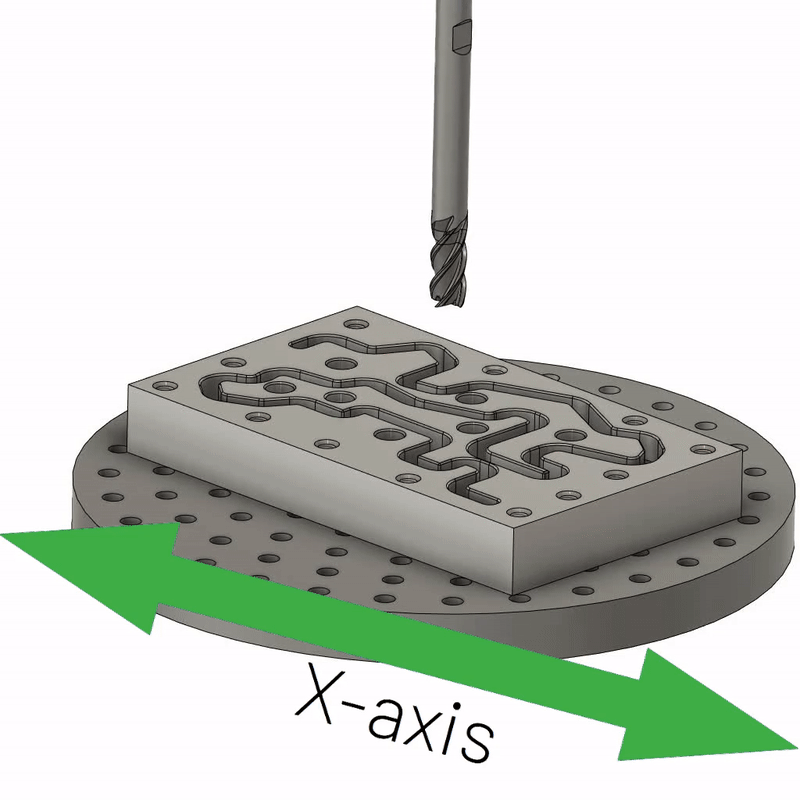
3-axis machining
Advantages
Cost-effectiveness: 3-axis CNC machines are generally more affordable than their 4-axis and 5-axis counterparts, making them a cost-effective solution for many applications.
Simplicity: Programming and operating 3-axis machines is relatively simple, requiring less training and expertise compared to more advanced CNC machines.
High repeatability and precision: For simple parts, 3-axis CNC machining offers excellent repeatability and precision, ensuring consistent quality across production runs.
Limitations
Restricted geometries: 3-axis machines are limited to creating simple geometries and cannot easily produce complex shapes or undercuts.
Multiple setups: Machining complex parts on a 3-axis CNC often requires multiple setups, which can increase production time and costs.
Lower productivity: For intricate designs, 3-axis machining may have lower productivity compared to 4-axis or 5-axis machines, as it cannot perform simultaneous cutting operations.
Common Applications and Industries
3-axis CNC machining is widely used in various industries, including:
Automotive: Engine components, brackets, and simple body parts
Aerospace: Simple structural components and mounting hardware
Medical: Basic surgical tools and implant components
Electronics: Enclosures, heatsinks, and simple PCBs
Ideal Applications
3-axis CNC machining is best suited for:
Planar profiles and shallow cavities
Drilling and threading operations
Simple parts with limited complexity
4-Axis CNC Machining
4-axis CNC machining is an advanced machining process that adds a rotary axis (A-axis) to the standard X, Y, and Z axes found in 3-axis machining. This additional axis allows the workpiece to rotate around the X-axis while the cutting tool performs its operations.
How the A-Axis Works
In a 4-axis CNC machine, the A-axis is typically achieved by mounting the workpiece on a rotary table or a chuck. As the cutting tool moves along the X, Y, and Z axes, the workpiece simultaneously rotates around the X-axis (A-axis). This rotation enables the cutting tool to access different sides of the workpiece without the need for manual repositioning.
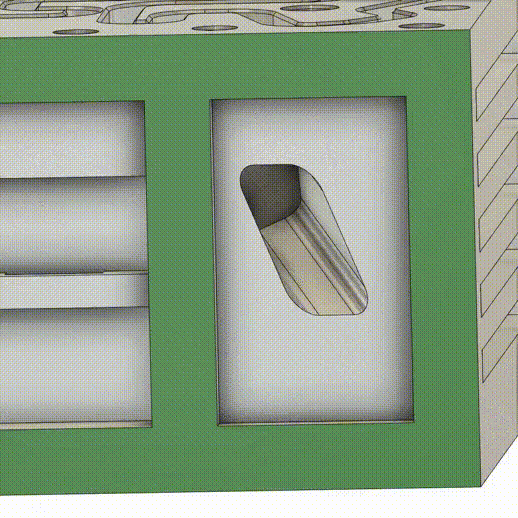
Milled feature angled in a single plane at 45°
Types of 4-Axis Machining
There are two main types of 4-axis machining:
Indexing: The A-axis rotates to a specific angle and then locks in place while the cutting tool performs its operations. Once complete, the A-axis rotates to the next desired angle, and the process repeats.
Continuous: The A-axis rotates continuously while the cutting tool is in motion, allowing for the creation of complex, curved surfaces and contours.
Advantages over 3-Axis Machining
Reduced setups: 4-axis machining allows multiple sides of a workpiece to be machined in a single setup, reducing the need for manual repositioning and shortening overall cycle times.
Improved precision: By minimizing the number of setups, 4-axis machining maintains higher precision and tighter tolerances for multi-sided parts.
Limitations
Single-plane rotation: 4-axis machining is limited to rotation around a single axis (X-axis), which may not be suitable for parts requiring complex, multi-axis movements.
Tool accessibility: In some cases, the rotary table or chuck can obstruct tool access to certain areas of the workpiece, limiting the complexity of geometries that can be achieved.
Ideal Applications
4-axis CNC machining is particularly well-suited for:
Parts with angled surfaces or features
Turbine blades and propellers
Curved profiles and contours
Multi-sided components requiring high precision
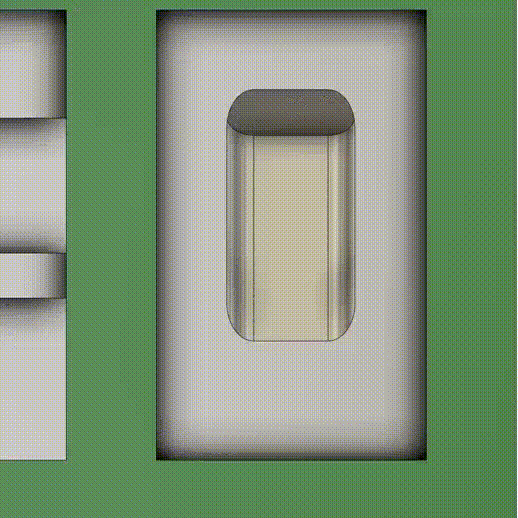
A unique setup is required for each side of a part
5-Axis CNC Machining
5-axis CNC machining is the most advanced and versatile type of CNC machining. It adds two more rotary axes (B and C) to the standard X, Y, and Z axes found in 3-axis machining. These additional axes allow the cutting tool or the workpiece to tilt and rotate, enabling the creation of highly complex geometries and sculpted surfaces.
How B and C Axes Work
In 5-axis CNC machining, the B-axis typically refers to the rotation around the Y-axis, while the C-axis refers to the rotation around the Z-axis. These rotary axes can be positioned on the machine table (trunnion-style) or the spindle head (swivel-style). The combination of these axes with the linear X, Y, and Z axes allows the cutting tool to approach the workpiece from nearly any angle.
Types of 5-Axis Machining
3+2 Axis Machining: Also known as positional 5-axis machining, this method involves positioning the workpiece using the B and C axes, then locking them in place while the cutting tool performs operations using the X, Y, and Z axes.
Fully Continuous 5-Axis Machining: In this method, all five axes move simultaneously and continuously during the machining process. This enables the creation of highly complex, sculpted surfaces and contours.
Advantages
High precision and complex geometries: 5-axis machining can produce parts with intricate shapes, deep cavities, and undercuts that are difficult or impossible to achieve with 3-axis or 4-axis machining.
Reduced machining time: By allowing the cutting tool to access multiple sides of the workpiece in a single setup, 5-axis machining reduces overall machining time and improves efficiency.
Ideal for high-precision parts: The enhanced tool positioning and access capabilities of 5-axis machining make it suitable for producing high-precision parts with tight tolerances.
Limitations
High cost: 5-axis CNC machines are significantly more expensive than their 3-axis and 4-axis counterparts due to their advanced capabilities and complex construction.
Programming complexity: Creating programs for 5-axis machining requires advanced CAM software and skilled programmers familiar with multi-axis toolpath generation.
Operator skill: Operating 5-axis CNC machines demands highly skilled and experienced operators to ensure optimal results and avoid costly errors.
Ideal Applications
5-axis CNC machining is commonly used in industries that require complex, high-precision parts, such as:
Aerospace components (turbine blades, impellers)
Medical implants and prosthetics
Defense and military equipment
Molds and dies with intricate shapes
Factors in Choosing CNC Machining Configurations
Selecting the best CNC machine setup requires analyzing several key factors. Whether for simple parts or intricate designs, each configuration—3-axis, 4-axis, and 5-axis—offers distinct advantages based on production goals, design needs, and budget.
Complexity of Part Geometries
The complexity of the part geometry is a primary consideration when choosing between 3-axis, 4-axis, and 5-axis CNC machining. Simple parts with planar surfaces and straight cuts are well-suited for 3-axis machining, while parts with angled features or curved surfaces in a single plane may require 4-axis machining. For highly complex, sculpted surfaces and intricate geometries, 5-axis machining is often the best choice.
Machining Precision and Accuracy
The level of precision and accuracy required for your project is another essential factor. 3-axis machining is suitable for parts with moderate precision requirements, while 4-axis machining offers improved precision for multi-sided parts due to reduced setups. 5-axis machining provides the highest level of precision and accuracy, making it ideal for complex parts with tight tolerances.
Setup Times and Efficiency
Setup times can significantly impact overall production efficiency. 3-axis machining may require multiple setups for complex parts, increasing production time and costs. 4-axis machining reduces setup times by allowing multiple sides of a part to be machined in a single setup. 5-axis machining offers the most efficient setup times, as it can handle complex parts with minimal setups.
Cost Considerations
The cost of the CNC machine, operator training, and maintenance should also be taken into account. 3-axis machines are the most affordable option, with lower investment and maintenance costs. 4-axis machines have a moderate cost, higher than 3-axis but lower than 5-axis machines. 5-axis machines are the most expensive due to their advanced capabilities, required skill level, and maintenance needs.
Production Volume
The production volume of your project can also influence the choice of CNC machining configuration. For low-volume production or prototyping, 3-axis machining may be the most cost-effective solution. As production volumes increase, the efficiency and reduced setup times of 4-axis and 5-axis machining can lead to lower per-part costs and faster turnaround times, making them more suitable for high-volume production.
Flexibility in Design and Manufacturing
The flexibility in design and manufacturing offered by each CNC machining configuration should also be considered. 3-axis machining has limited design flexibility and is best suited for simple, straightforward parts. 4-axis machining provides increased flexibility for parts with angled features and curved surfaces. 5-axis machining offers maximum design flexibility, enabling the creation of highly complex parts with intricate geometries.
Conclusion
Choosing between 3-axis, 4-axis, and 5-axis CNC machining depends on each project's complexity, precision needs, and budget. 3-axis is perfect for simpler, flat designs; 4-axis adds rotational flexibility for angled features, while 5-axis machines handle complex, multi-sided geometries in a single setup. Understanding these differences is essential for maximizing productivity and cost-efficiency in manufacturing. Selecting the right configuration ensures precision, reduces setup time, and optimizes production for various industries, from aerospace to medical. Knowing when to use each axis type makes all the difference in efficient manufacturing.
Team Mfg understands the importance of selecting the right CNC machining configuration for your project. Our experienced team is here to guide you through the process, considering factors such as part complexity, precision requirements, production volume, and budget. Trust us to deliver the optimal solution for your manufacturing needs.
Reference Sources
numerical control
CNC Machining Services
Frequently Asked Questions (FAQs)
Q: What are the main differences between 3-axis, 4-axis, and 5-axis CNC machining?
A: The main differences lie in the number of axes along which the cutting tool can move. 3-axis machines have three linear axes (X, Y, Z), 4-axis adds one rotary axis (A or B), and 5-axis machines have three linear and two rotary axes (A/B and C).
Q: How do I decide between 3-axis, 4-axis, and 5-axis CNC machining for my project?
A: Consider factors such as part complexity, precision requirements, production volume, and budget. 3-axis is suitable for simple parts, 4-axis for parts with angled features, and 5-axis for complex, sculpted geometries. Higher-axis machines offer more flexibility but come at a higher cost.
Q: What are the advantages of using a 5-axis CNC machine compared to a 3-axis machine?
A: 5-axis CNC machines can produce complex, contoured parts in a single setup, reducing the need for multiple setups and improving accuracy. They also allow for shorter tool lengths, reducing tool vibration and improving surface finish. However, 5-axis machines are more expensive and require skilled operators.
Q: How do I program a 4-axis CNC machine?
A: Programming a 4-axis CNC machine involves defining the tool paths for the three linear axes (X, Y, Z) and the additional rotary axis (A or B). You'll need to use CAM software that supports 4-axis machining and has post-processors for your specific machine. The software will help you create the G-code that controls the machine's movements.
Q: What are some common applications for 4-axis and 5-axis CNC machining?
A: 4-axis machining is often used for parts with angled features, such as turbine blades, impellers, and spiral flutes. 5-axis machining is ideal for complex, sculpted geometries found in aerospace, medical, and automotive components, such as engine parts, prosthetics, and mold tooling. Both 4-axis and 5-axis machining can improve efficiency and precision for certain parts compared to 3-axis machining.



















